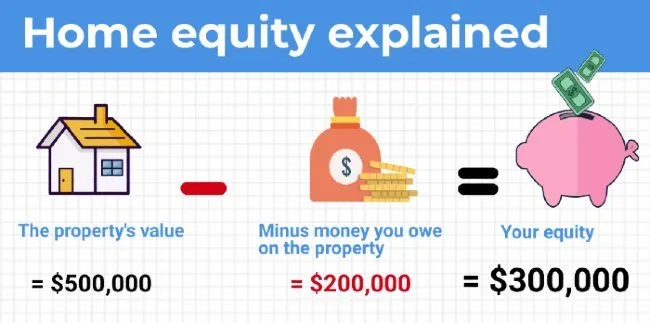If you're looking to invest in property, a line of credit loan could be a great way to leverage the equity in your existing property for a deposit. A home equity loan is a loan in which you put your property up as security to borrow against the equity of your home.
What is equity?
Equity is the value in your home, minus your debt. If your home is worth $700,000 and you owe $500,000 on your home loan, you have $200,000 in equity.
You build equity in your home in two ways: through making your regular home loan repayments and through price appreciation. If you've been paying your home loan for a number of years, you will have reduced the principal, or initial amount you borrowed. At the same time, your home may have increased in value. The combination of the increase in value and the reduction in principal adds up to equity.

How does a line of credit let me access my equity?
A line of credit loan usually allows you to borrow up to 80% of the value of your equity, and this amount is given to you as a credit limit. You can use as much or as little of the credit limit as you like, and you're only charged interest on the amount you use.
Finder survey: What is the most important factor for people when choosing an investment loan?
| Interest rate | 5.78% | 3.56% |
| Interest only repayments | 0.77% | 1.36% |
| Extra repayments | 0.58% | 1.02% |
| Offset account | 0.96% | 0.51% |
| Ability to split loan | 0.19% | 0.34% |
| Fast approval process | 0.19% | 0.17% |
| The lender | 0.19% | 0.17% |
| Other | | 0.17% |
Source: Finder survey by Pure Profile of 1112 Australians, December 2023
How can I use a line of credit to invest in property?
You can use a line of credit to form the deposit for an investment property. If you have a significant amount of equity in your home, a line of credit loan could potentially account for most or all of your deposit.
A line of credit loan only requires you to pay the interest portion of the loan until you reach your credit limit. This can be a savvy move for property investors, as interest repayments on investment properties are tax deductible.
If you don't use your entire credit limit for a deposit, you can also set aside part of your line of credit for any urgent repairs or maintenance on your investment property. This can help you manage your cash flow.
You'll most likely need to couple your line of credit with an investment home loan.
What are the drawbacks of using a line of credit loan to invest in property?
While a line of credit loan can help you invest in property sooner and carries significant tax advantages, there are some drawbacks.
First, using a line of credit loan to invest in property could potentially see you managing three home loans. Between your owner-occupier home loan, the line of credit and an investment loan, using a line of credit for property investment can be cumbersome.
Another drawback of line of credit loans is that you're using your own home as security. This means that if you run into trouble repaying your line of credit when it's due, your lender could seek recourse through your property and, in the worst case scenario, could even foreclose on your home.
What are some tips for using a line of credit for property investment?
Using a line of credit as an effective property investment tool requires some strategy. Here are some tips to keep in mind:
- Try to avoid using your entire credit limit. Leave yourself a buffer so you don't have to make principal and interest repayments on the line of credit.
- Leaving a buffer also allows you to use your line of credit for repairs and maintenance
- Devote extra funds to repaying your owner-occupier home loan. This unlocks more equity and minimises your non-tax deductible debt
How do I compare line of credit loans?
Line of credit loans are relatively straightforward products, so the best way to compare them is to analyse the interest rates and fees.
Line of credit loans come with higher interest rates than typical home loans, and rates can vary substantially from one lender to the next. It's important to compare to make sure you're getting the best deal available.
Most line of credit loans also carry ongoing fees. This covers the administrative cost of managing the loan account. These fees are typically charged monthly.
Some line of credit loans are also available as home loan packages. A package offers interest rate discounts along with discounts and special offers on other financial products. These typically charge higher fees, but these fees could easily be offset by the savings offered on other products.
If you've been diligent in repaying your home loan, and if you've been lucky enough to see your home grow in value, a line of credit loan could offer a great way to put your equity to work for you. But, as with all financial products, it's important to compare your options and consider your own financial situation before you make a decision.
